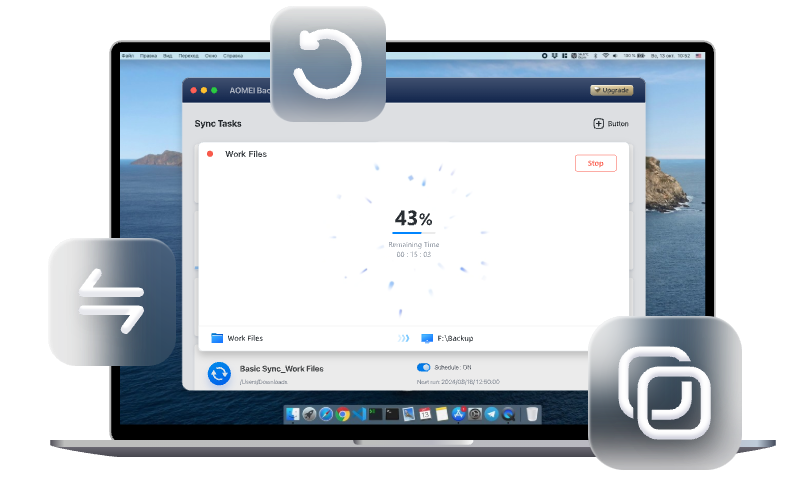Unlocking Efficiency: Use Robocopy Alternatives for Mac
This article delves into the best Robocopy alternatives for Mac, providing detailed solutions for efficient data management and synchronization. We will discuss various methods and tools, their features, and how to use them effectively.
Introduction to Robocopy
Robocopy, short for "Robust File Copy," is a command-line tool originally developed by Microsoft for Windows systems. It is renowned for its robust capabilities of inefficiently copying and synchronizing files and directories. While Robocopy is primarily designed for Windows, Mac users can achieve similar functionalities using alternative command-line tools or graphical interfaces.
Is Robocopy available on MacOS?
Unfortunately, it is not natively available on macOS. However, Mac users can achieve similar functionality using the Robocopy alternative for Mac. In this comprehensive guide, we will explore how to replicate Robocopy's capabilities on a Mac, ensuring seamless data management and synchronization.
Robocopy Alternatives for Mac
Solution 1: Using Rsync on Mac
While Robocopy isn't working on a Mac, you might want to try using Rsync as an alternative to copying files as backups on a Mac. Here is how to make it happen:
Step 1: Go to Applications > Utilities > Terminal. app. Use Spotlight by pressing Command + Space, then type "terminal" and hit Enter.
Step 2: In the Terminal, type: rsync -ahP but don't press Enter yet.
Step 3: Drag the folder you want to copy and drop it into the Terminal window. This is your source folder.
Step 4: Drag the folder where you want the files to go and drop it into the Terminal window. This is your destination folder.
Step 5: Add this to the end of your command: 2> ~/Desktop/rSyncErrors.txt.
Step 6: Press Enter. You will see the files transferring. If there are many files, it will be completed quickly. Just wait for it to finish.
⭐Rsync Commands and Options:
Syntax: Rsync follows the basic syntax: rsync [options] source destination.
Example: To copy files from a source directory to a destination, use: rsync -avh /path/to/source/ /path/to/destination/.
Recursive Copy: Use the -r option for recursive copying.
Preserve Attributes: Use -a to preserve file attributes.
Verbose Output: Use -v for detailed output.
Human-Readable Format: Use -h for human-readable file sizes.
Solution 2: Using ChronoSync on Mac
Step 1: Visit the ChronoSync website and download the latest version. Follow the installation instructions to set up ChronoSync.
Step 2: Open ChronoSync and create a new synchronizer document. Choose your source and destination directories. Customize sync options like bidirectional sync and scheduling.
Step 3: Configure the timing and frequency for the sync task. Set up notifications for sync completion and errors.
Step 4: Click "Synchronize" to start the initial process. Monitor the progress and review any issues.
Step 5: Use ChronoSync to automate and manage multiple sync tasks. Regularly check sync reports for any discrepancies.
Solution 3: Using File Sync Software for Mac
If none of these alternatives work for you, or you want to try something else with Mac file synchronization tools, consider using AOMEI Backupper Mac. This software makes it easy to sync important files from your Seagate drive to your Mac. Its user-friendly interface and powerful features ensure your data is protected efficiently and reliably.
Free Mac sync software to sync files and folders automatically
Step 1: Download and install the software on your Mac. Open the application and click "New Task" to begin.
Step 2: Choose the synchronization method that fits your needs. Options like Basic Sync, Mirror Sync, or Two-Way Sync are ideal for syncing.
📌Basic Sync: Copies files from one folder to another without removing the originals from the source.
📌Mirror Sync: Creates an exact replica of the source files at the destination, deleting any files in the destination that no longer exist in the source.
📌Two-Way Sync: Keeps both the source and destination folders updated, ensuring that changes in one are reflected in the other.
Step 3: Specify the folders or drives you want to sync.
Step 4: Customize the sync schedule and other options to suit your requirements.
You can decide how frequently to sync your files, with options like once, hourly, daily, weekly, or monthly. Additionally, you can set a specific start time and choose whether the system should hibernate or shut down after the sync completes.
In the options, you can customize the sync process by including or excluding specific files and folders to suit your needs.
Step 5: Click the "Sync" button to start the process and wait for it to complete.
Frequently Asked Questions (FAQs)
Q 1: What are the best Robocopy alternatives for Mac?
A 1: Rsync, ChronoSync, and AOMEI Backupper Mac are among the top alternatives for Robocopy on macOS, each offering powerful file synchronization and backup capabilities.
Q 2: How do I sync files between multiple Macs?
A 2: Use AOMEI Backupper Mac over the network sync features to synchronize files between multiple Mac systems.
Q 3: What are the benefits of third-party sync tools over macOS built-in tools?
A 3: Third-party tools provide advanced features, greater customization, and better automation capabilities compared to built-in macOS tools.
Tips for Efficient File Synchronization
Regularly Schedule Sync Tasks: Automate your sync tasks to run during off-peak hours to avoid performance issues.
Use Verification Options: Enable checksum verification to ensure data integrity during synchronization.
Monitor Sync Logs: Regularly review sync logs for errors or conflicts to address issues promptly.
Conclusion
Finding the best Robocopy alternatives for Mac involves understanding your specific data management needs and selecting the right tools. Rsync, ChronoSync, and GoodSync offer robust features and flexibility, ensuring efficient file synchronization and backup. By following the detailed solutions and tips provided in this article, you can seamlessly manage your data on macOS, achieving reliability and peace of mind.

